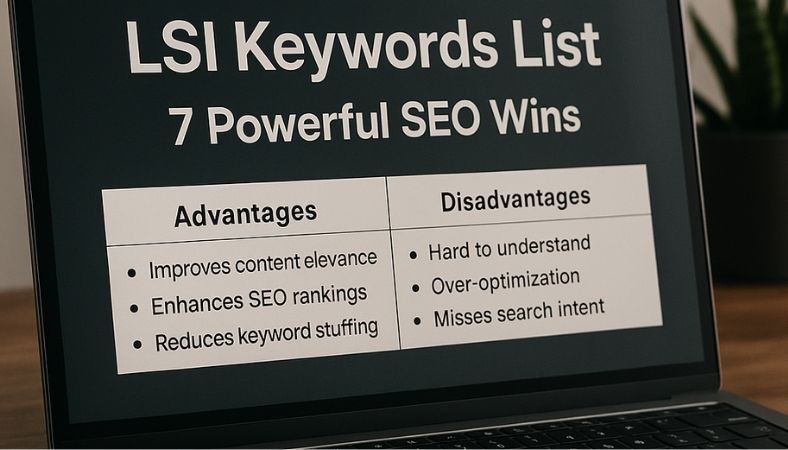Introduction
Every day, millions search the web. Most want fast, accurate answers. Your job is to meet that need. Search engines rely on more than just exact words. They look for relationships between words. This is where LSI keywords help. An LSI keywords list makes your content more relevant. It improves how search engines understand your message. If you’re aiming to rank higher, you can’t skip semantic keywords. This article breaks down how to build and use them. SEO writing tricks are clever ways to boost content.
Let’s explore the hidden powers of the LSI keywords list and what it can do for your SEO.

What Are LSI Keywords?
LSI stands for Latent Semantic Indexing. It’s a concept that helps search engines find related terms. Search engines scan your content. They look for words and phrases that naturally relate to the main keyword.
For example, if your keyword is “apple,” LSI keywords could include “fruit,” “orchard,” or “iPhone.”
These related terms provide meaning and context to your content. Google uses these to deliver better search results. Contrary to popular belief, LSI isn’t just synonyms. It’s about semantic relationships how words connect logically.
So, an LSI keywords list helps you cover topics more deeply and clearly.
LSI Keywords vs Traditional Keywords
Traditional keywords are exact match terms. LSI keywords go beyond that. They explore the meaning behind the search. For instance, “car” and “engine” aren’t synonyms. But they’re semantically related. That’s what makes them LSI.
How Google Uses Semantic Search
Google now uses Natural Language Processing (NLP). It understands the intent behind your search, not just the words.With BERT and other algorithms, Google looks for full context. LSI keywords help form that context.
Step-by-Step Guide to Building an LSI Keywords List
Creating an effective LSI keywords list isn’t hard. You just need the right approach.
Step 1: Start with a Focus Keyword
Every SEO strategy starts with a foundation keyword. This is the main term around which you will build your content. Let’s say you run a fitness blog. Your focus keyword might be “home workouts”. This will serve as your seed keyword.
Once you’ve chosen the focus keyword, ask yourself:
What does my audience want to know about this topic?
Is the keyword broad or narrow?
Can I support this topic with in-depth content?
Choosing a keyword that is too broad (like “fitness”) may make it hard to rank. Too narrow (like “5-minute HIIT for seniors with bad knees”) limits traffic potential. Your LSI keywords list will help you strike the balance.
Step 2: Use LSI Keyword Tools
To uncover related keywords, leverage tools that provide semantic terms.
Recommended Tools:
| Tool | Free Plan | Use Case |
|---|---|---|
| LSIGraph | Yes | Simple UI for LSI terms |
| Surfer SEO | Limited | Integrates LSI into content optimization |
| SEMrush | No | Advanced keyword clustering |
| Ahrefs | No | Deep keyword research & difficulty metrics |
| Ubersuggest | Yes | Offers basic keyword and LSI suggestions |
Tip: Use 2-3 tools to cross-reference terms. You’ll often find overlapping suggestions, which strengthens your LSI list.
Step 3: Analyze Search Intent
Search intent tells you why someone is typing a specific query. There are four main types:
Informational: “What are LSI keywords?”
Navigational: “LSIGraph login”
Transactional: “Buy LSI keyword tool”
Commercial Investigation: “Best LSI keyword tool for bloggers”
Your LSI keywords should match your intent. For instance, if your article is informational, avoid inserting sales-focused LSI terms. Use Google’s search results as a clue. If most top results are blog posts, it’s informational. If they’re product pages, it’s transactional.
Step 4: Build Contextual Keyword Clusters
Instead of writing content around a single keyword, create keyword clusters. These are groups of related terms that form subtopics.
Here’s how you do it:
Use a spreadsheet to organize related keywords.
Group them by theme (e.g., tools, benefits, how-to).
Assign one cluster per section in your article.
Example:
If your keyword is “email marketing,” clusters could be:
Tools for email marketing
Benefits of automation
Best subject lines
Email metrics to track
This strategy boosts topical authority and keeps users engaged longer.
Step 5: Implement LSI Keywords Naturally
LSI terms should feel like a natural part of your writing. Here’s how to do that without sounding robotic:
Insert them in subheadings
Use them in image alt text
Mention in first and last paragraph
Include in bullet points or tables
Example of poor usage:
“LSI keywords are LSI keywords that help you with LSI keyword SEO.”
Better version:
“LSI keywords support your SEO by adding contextual meaning to your content.”
Aim for clarity, not just keyword density.
Advantages of Using an LSI Keywords List
Let’s explore the powerful benefits of using LSI keywords in more detail.
Improves Content Relevance
Search engines aim to serve users the most relevant content. When you use LSI terms, your article speaks more directly to the user’s needs.
For example, in an article about “digital marketing”, including LSI terms like “SEO strategies”, “content creation”, and “email automation” shows you understand the topic fully.
Enhances SEO Rankings
Google doesn’t just reward content that contains the main keyword. It ranks pages that cover the topic in depth.
Using an LSI keywords list:
Increases your time on page (due to better engagement)
Reduces bounce rate (users find what they need)
Improves crawlability (Google understands your site better)
That combination leads to stronger rankings over time.
Reduces Keyword Stuffing Risks
Keyword stuffing ruins both SEO and user experience. LSI keywords help you diversify your vocabulary while staying relevant.
Instead of saying “best protein powder” 15 times, you could say:
“muscle recovery supplements”
“post-workout nutrition”
“whey isolate options”
This keeps your content natural and informative without risking penalties.
Disadvantages and Common Pitfalls
Even though LSI is helpful, it can hurt your content when misused.
Misunderstanding What LSI Keywords Are
Beginners often mistake LSI keywords for basic synonyms. This leads to irrelevant additions.
For instance, if your focus keyword is “running shoes,” adding terms like “footwear fashion” or “heels” may not be semantically useful.
Instead, look for true contextual matches like “marathon training,” “cushion support,” or “trail running”.
Over-Optimization Risk
When you cram too many LSI terms into your text, it becomes unnatural.
Search engines can detect this. Readers sense it too. Always write for humans first and optimize second.
Use a tool like Yoast SEO or Surfer SEO to track keyword usage.
Not Keeping Intent in Mind
If you ignore intent, your article won’t connect with the reader.
An article meant for beginners shouldn’t include overly technical LSI terms. That alienates readers and reduces time on page.
Stay aligned with your audience’s level of knowledge.
Frequently Asked Questions
What is an LSI keywords list used for?
It helps search engines understand your content. It makes your page more contextually rich.
Are LSI keywords still important in 2025?
Yes. Though Google denies using LSI technology, it still values semantic context.
Can I find LSI keywords manually?
Yes. Use Google Autocomplete, “People Also Ask”, and related searches.
How many LSI keywords should I use?
Use 10–15 per article. Spread them across headings and body text.
Do LSI keywords affect on-page SEO?
Absolutely. They improve relevance, structure, and clarity—all key for on-page success.
Are there free tools to build an LSI keywords list?
Yes. Tools like Ubersuggest and LSIGraph offer free versions.
Bonus: Tools to Generate a Powerful LSI Keywords List
You don’t need expensive tools to build a powerful LSI keywords list—but they do help.
Free Tools Worth Using
Google Autocomplete: Start typing your keyword and note what appears.
Google People Also Ask: Use these queries to form LSI-rich subheadings.
LSIGraph: Gives simple lists of semantic terms.
Ubersuggest: Offers LSI suggestions with search volume and CPC.
AnswerThePublic: Maps out search questions and clusters.
Paid Tools for Pros
Surfer SEO: Offers NLP-based keyword suggestions using AI.
SEMrush Topic Research: Finds content ideas and related keywords.
Ahrefs Content Explorer: See what’s ranking and which keywords they use.
These tools help you build structured, keyword-optimized content that aligns with search engine goals.
Conclusion
By now, you’ve seen the power of using an LSI keywords list. It’s no longer enough to stuff content with one keyword and hope for results. Today’s SEO demands context, structure, and semantic depth. LSI keywords help you achieve that without sacrificing user experience. They increase your authority in the eyes of Google. More importantly, they help readers understand your content better. Start by picking your focus keyword. Use the tools we shared. Organize your clusters. Then weave those LSI terms naturally into your article.

